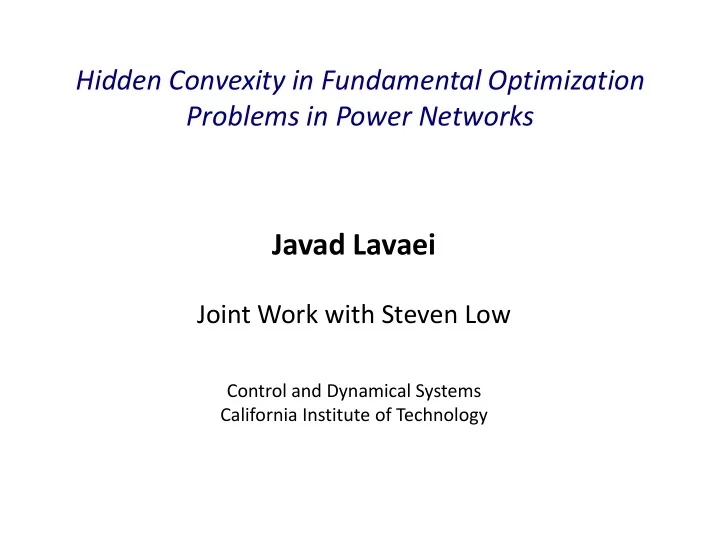

Hidden Convexity in Fundamental Optimization Problems in Power Networks Javad Lavaei Joint Work with Steven Low Control and Dynamical Systems California Institute of Technology
Power Networks (TPS 11, IFAC 11, ACC 11, CDC 10, Allerton 10 ) Nonlinearity of physical laws Hard optimizations Extensive literature since 1962 Passivity simplifies optimization for practical power networks Generalizable to many problems in smart grids Javad Lavaei, California Institute of Technology 1
Power Networks: Optimal Power Flow (OPF) Controllable Params: Active power Voltage magnitude Transformer ratio Shunt element… Constraints: KCL & KVL Physical Security Stability… Importance: Solved every 5-15 mins for market and operation planning. Javad Lavaei, California Institute of Technology 2
Power Networks: Needs for New Algorithms Previous Attempts Since 1962: Linear programming Findings by OR and Power People: Interior point method Multiple local solutions Nonlinear programming Disconnected region Dynamic programming Convexification for trees Lagrangian relaxation Genetic algorithms.... Existing algorithms lack: Challenges for smart grid: Robustness Scalability issue (100X) Performance guarantee Time-varying renewable Global optimality guarantee Pricing mechanism (LMP) Javad Lavaei, California Institute of Technology 3
Power Networks: Summary of Results Goal: Find a global solution in polynomial time Idea: Physical structure on OPF First result : A sufficient condition to solve OPF Surprising result: Condition holds on IEEE benchmark systems Important result: Condition holds widely in practice due to passivity Promising result: Generalization to many optimizations in smart grids Javad Lavaei, California Institute of Technology 4
Power Networks: Summary of Results Other results: Certificate for global optimality Shape of feasibility region Multiple solutions to power flow Existence of competitive equilibrium points Mechanism design Javad Lavaei, California Institute of Technology 5
Power Networks: OPF Formulation Modeling: Lumped model with admittance Y OPF: Define X based on voltages Constraints of degrees 2 and 4 Javad Lavaei, California Institute of Technology 6
Power Networks: Weak Duality Strong Duality LMI LMI ? Replace with W Weak Impose W to be PSD Duality Rank Relaxation OPF BMI Lemma: Zero duality gap if SDP relaxation has a rank-one solution. IEEE Systems: Rank-two solutions. Javad Lavaei, California Institute of Technology 7
Power Networks: Strong Duality Strong Duality LMI LMI ? Weak Duality Rank Relaxation OPF BMI Important Constraint in Dual OPF: Theorem: Zero duality gap if rank A at optimality is at least 2n-2 . Javad Lavaei, California Institute of Technology 8
Power Networks: Zero Duality Gap Recall the constraint We trade power based on Normal condition: Non-negativity of (rigorous proof) Theorem (real case): Zero duality gap under normal condition. Sketch of proof: Use passivity and Perron-Frobenius Theorem. Javad Lavaei, California Institute of Technology 9
Power Networks: Zero Duality Gap Lumped Model: Transmission lines, transformers and FACTS Devices are resistive + inductive. Story of “normal condition” is much more complicated. Another challenge: Local Theorem: Zero duality gap for a small power loss. Global Theorem: Given Re(Y) , zero duality gap independent of loads if Im(Y) belongs to an unbounded region. Javad Lavaei, California Institute of Technology 10
Power Networks: More Advanced Problems More Constraints More Variables OPF with variable shunt elements OPF with variable transformer ratios Theorem: Zero duality gap for Dynamic OPF OPF implies zero duality gap for Security-constrained OPF all these problems. Scheduling for renewable resources … Proof: Good modeling: Javad Lavaei, California Institute of Technology 11
Power Networks: Impacts Fundamental study of optimizations in power networks Potential to change optimization algorithms for grids Example 1: Global solution 15% better than local solution for modified IEEE 57-bus system Example 2: One generator and one load Multiple solutions Able to find them all by changing the cost function Javad Lavaei, California Institute of Technology 12
Economic Dispatch Various feasibility regions: Economic Dispatch: Javad Lavaei, California Institute of Technology 13
Mechanism Design Javad Lavaei, California Institute of Technology 14
Competitive Market Existence of CEP: Javad Lavaei, California Institute of Technology 15
Conclusions Laws of physics introduce nonlinearity. OPF is NP-hard and has been studied for 50 years. A large class of OPF problems can be convexified. The main reason is the physical properties of the network. This idea is useful to study many other related problems. Javad Lavaei, California Institute of Technology 16
Recommend
More recommend